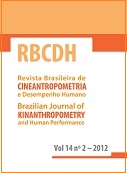Interdisciplinary intervention on body composition and physical fitness tests in obese children
DOI:
https://doi.org/10.1590/1980-0037.2012v14n2p134Abstract
Lifestyle changes are an important factor in the management and prevention of childhood obesity. The objective of this study was to analyze the effects of an exercise program (based on recreational activities) and nutritional counseling on body composition and physical fitness test performance in obese children. Forty-four children aged 8 to 11 years were divided into two gender- and age-matched groups, intervention (n = 22) and control (n = 22). Several parameters were measured before and after 12 weeks of participation in the program: weight, height, skinfold thickness (biceps, triceps, subscapular, suprailiac, abdominal and medial calf), circumferences (abdominal, arm, hip and calf) and the abdominal flexion and handgrip flexibility tests. The control group did not take part in the intervention. Thirty-two patients completed the study (16 in each group). The intervention group showed significant reductions in body mass index, triceps, subscapular and abdominal skinfold thickness, arm girth and sum of trunk skinfolds. There was a significant increase in right grip strength and abdominal strength. The control group showed a significant increase in body mass, waist circumference, subscapular and calf skinfold thickness, sum of trunk skinfolds, sum of limb skinfolds and arm and calf perimeters, as well as reduction in right hand grip strength. We conclude that the program was effective in reducing body fat and increasing physical fitness in children.



